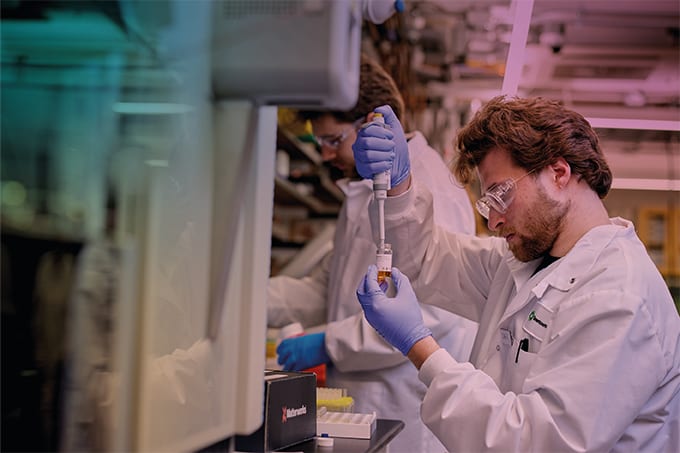
Once believed to function solely in fat digestion, bile acids (BAs) are now recognized as complex metabolic regulators with significant roles in immunity, inflammation, and microbial interactions.
They cycle through the liver and intestines during enterohepatic circulation, in a process vital to GI health. Disruptions to this cycle can lead to various GI diseases. For instance, bile acid dysregulation is linked to inflammatory bowel disease (IBD), where inflammation in the intestinal lining is influenced by abnormal bile acid profiles. An imbalance in bile acids can worsen inflammation and disrupt gut homeostasis, emphasising the importance of accurate bile acid profiling.
Bile acid dysregulation is also a key contributor to symptoms in microvillus inclusion disease – a rare genetic disorder causing severe malabsorption and diarrhea. Bile acid analysis can reveal imbalances that can exacerbate malnutrition and stress the GI system. In intrahepatic cholestasis of pregnancy, for example, bile acid concentrations become elevated in the bloodstream during pregnancy, with potential effects to both the mother and fetus.
Understanding how specific bile acids contribute to disease progression is crucial for developing targeted treatments. But this is not without challenge – especially from an analytical perspective.
Challenges in bile acid analysis
Primarily synthesized in the liver from cholesterol, bile acids undergo various modifications following interactions with gut microbiota and host enzymes. This results in various bile acid structures, each with minor variations that can produce biological effects with significant differences. Including primary, secondary and tertiary forms, their structural diversity in particular poses a number of quandaries within analytical chemistry. The continual discovery of thousands of microbial-conjugated bile acid species raises the difficulty in developing an analytical method capable of accurately quantifying each relevant species.
A further complication to bile acid analysis is isomerism. Many bile acids share the same molecular formula while differing in structure, with mono-, di- and tri-hydroxylated forms. Certain isomers share the same exact mass for their precursor ion in negative ionization mode and produce similar fragments under collision-induced dissociation (CID) in MS, which complicates their quantitative analysis. As they cannot be distinguished using CID-based fragmentation alone, effectively resolving these isomers requires careful considerations to be made over chromatographic conditions.
Addressing these challenges come recent advancements in high resolution instruments for mass spectrometry. These instruments allow scientists to perform Electron Activated Dissociation (EAD) – a fragmentation technique that generates unique ions specific to each bile acid isomer. This enables researchers to distinguish between closely related structures without complete reliance on chromatography. Moreover, the method could make high-throughput bile acid analysis feasible in under 10 minutes – a marked improvement over traditional approaches.
Modern systems also enhance accuracy by overcoming chemical noise, which is particularly advantageous when analyzing complex samples containing many interfering compounds, such as feces. By selectively extracting fragment ions from the MS/MS spectrum, researchers can obtain cleaner signals which enable bile acids to be analyzed more accurately, even in challenging matrices.
Insights into GI disorders through bile acid profiling
The growing ability to precisely characterize bile acid profiles is transforming research in GI disorders. In IBD, for example, where inflammation is linked to immune imbalances, bile acid profiling can now reveal disruptions in gut microbiota that directly contribute to disease progression. Modern MS techniques allow researchers to quantify primary, secondary and tertiary bile acids in detail, allowing a closer examination of how bile acid imbalances affect immune responses and gut barrier function in patients with IBD.
Furthermore, bile acid profiling can reveal metabolic effects in conditions such as microvillus inclusion disease (MVID). By tracking their composition, scientists can better understand how defective bile acid trafficking exacerbates symptoms such as malabsorption and inflammation. These insights are crucial for developing therapies which function by restoring healthy bile acid profiles to alleviate malnutrition in MVID patients.
For intrahepatic cholestasis of pregnancy (IHCP), analysis of bile acids can help clarify the impact of maternal-fetal bile acid exchange on fetal development. Elevated bile acids during pregnancy have been linked to adverse outcomes such as premature or stillbirths, and distinguishing between individual bile acids can therefore help define how these metabolites influence maternal and fetal health. Discoveries in this area could lead to improvements in diagnostic tools, allowing clinicians to assess pregnancy risks based on bile acid profiles before offering precise interventions.
Future directions in bile acid analysis
As bile acids play a significant role in gut-liver, gut-brain and gut-immune system interactions as well as systemic health, their analysis is increasingly integrated with microbiome research. By combining MS with microbiome profiling, researchers can explore how gut bacteria affect bile acid composition and, in turn, influence host metabolisms. This approach may reveal novel bile acid derivatives with systemic effects to areas such as neurological health, potentially contributing to early diagnostics for neonatal and pediatric disorders.
Future advancements may also enable BA-targeted therapies to become a key part of personalized medicine for GI disorders, with tailored treatments addressing specific imbalances in bile acids. The use of dried fecal spot microsamples, inspired by newborn screening programs that use dried blood spots, represents another promising avenue. This microsampling technique could make bile acid analysis more accessible and cost-effective, expanding the diagnostic potential of BA profiling.
As bile acid chemistry continues to become more and more complex, advancements in analytical technologies promise to deepen our understanding of these vital molecules and their roles in health and disease. Moving forward, we predict that MS will play a crucial role in relation to this. By overcoming current challenges, researchers have never been more poised to unlock the therapeutic potential bile acids possess in treating and managing GI disorders.




